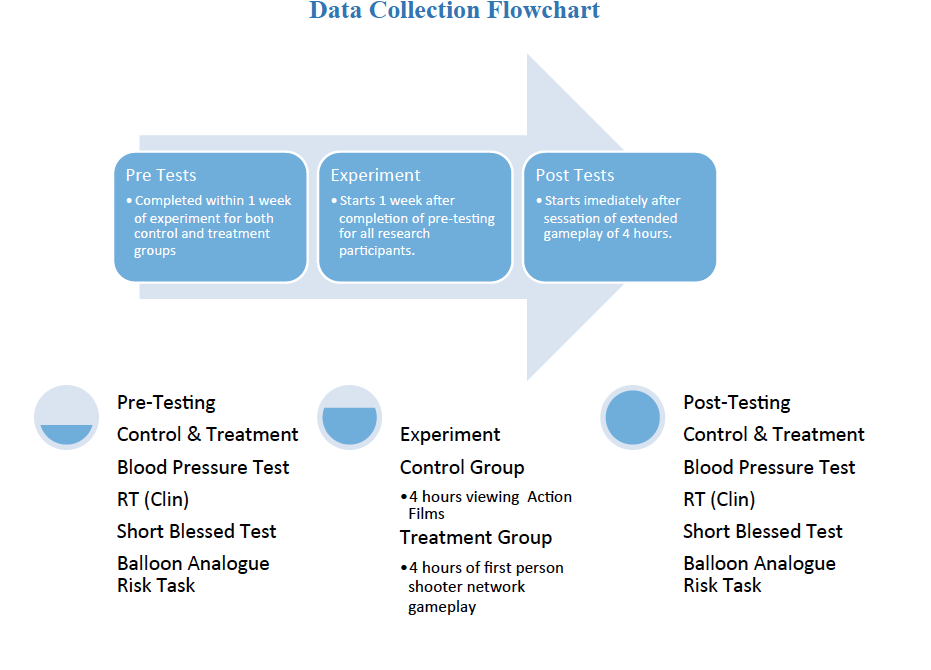Methods
Summary

The research questions for this study will include the following:
R1: Does Systolic and Diastolic Blood pressure increase in millennial males
following 4 hours of continuous gameplay?
H01: There is no relationship between systolic or diastolic blood pressure and 4
hours of continuous game play in millennial males.
H1: There is a relationship between systolic or diastolic blood pressure and 4
hours of continuous game play in millennial males.
R2: Does reaction time decrease in millennial males following 4 hours of
continuous gameplay?
H02: There is no relationship between reaction time and 4 hours of continuous
game play in millennial males.
H2: There is a relationship between reaction time and 4 hours of continuous game
play in millennial males.
R3: Is risk aversion hindered in millennial males following 4 hours of continuous
gameplay?
H03: There is no relationship between risk taking and 4 hours of continuous game
play in millennial males.
H3: There is a relationship between risk taking and 4 hours of continuous game
play in millennial males.
R4: Will memory be impaired in millennial males following 4 hours of continuous
gameplay?
H04: There is no relationship between cognition and 4 hours of continuous game
play in millennial males.
H4: There is a relationship between cognition and 4 hours of continuous game
play in millennial males.
Pre Analysis Plan
A Post-Hoc Power Analysis will be conducted to determine the sample size was
effective. In study population, 56% of men play video games (Entertainment Software
Association, 2015). Of millennial males, 34% have some college education < 4 years
(Taylor & Keeter, 2010). Millennial Generation Males that reside in Missouri total age
18-35 total 743,251 (Missouri Census Data Center, 2016). Power analysis parameters are
as follows. Population: 141,515 Effect Size: correlation coefficient of 0.50 Alpha: 0.05
Beta or Power: 0.20. To determine a finite representation of the distribution, measure of central tendency will be executed, mean, median, and mode. Standard deviation will be
calculated to express variability of the population. The process of Analysis will advance
by using a one-way MANOVA. With a single statistical test on the correlated dependent
variable the probability for false positives or Type I errors will be greatly reduced.
Conducting a MANOVA will reveal if there is an interaction effect as it will determine
how independent variables may influence some patterning of the responses and results of
the change scores (Levin, Fox, & Forde, 2014). Successively Wilk’s Lambda to pool the
variance from all the dimensions to create the test statistic followed by Cohen’s d to
standardize mean difference. If multivariate testing is significant then a post hoc analysis will be run to discern the nature of the differences. Plots of mean group differences will be created and checked for each DV (Levin, et.al., 2014). Hotelling’s T-square Test Statistic will be performed to determine if extended game play significantly altered the subject’s cognitive and
physiological functions as collected during pre and posttests. Mahalanobis distance
squared statistical measure calculations will reveal any cases of multivariate outliers. If
outliers are identified the cases will be further analyzed to ensure no miss entry of data
and if need be corrected or removed from the data set (Levin, et.al., 2014).
Protocols
Browse the protocols that are part of the experimental methods.